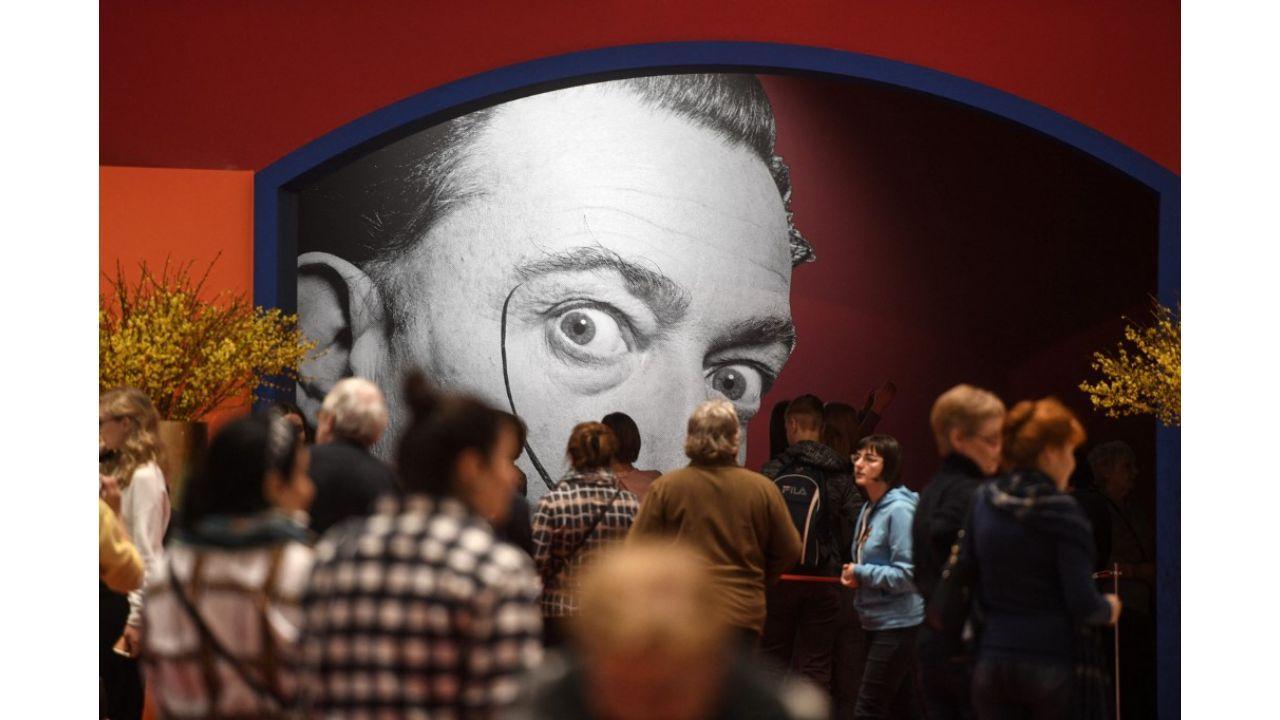Did you know Air India once gifted the Spanish painter an elephant? Or that he was removed from the Surrealist movement? On his birth anniversary, Mid-Day.com explores some fascinating aspects of Dali’s life

People walking past a large photograph of Spanish artist and surrealist icon Salvador Dali (1904 - 1989) at the exhibition "Salvador Dali - Magic Art" hosted at the Manege Central Exhibition Hall in Moscow on January 30, 2020. Alexander Nemenov/ AFP
That iconic moustache, how he broke the norms of conventional art, and his idiosyncratic brand of surrealism — these are things about the legendary artist Salvador Dali that are hotly discussed even today.
ADVERTISEMENT
His kind of surrealism touched not just paintings but extended into sculpture, film, and photography too. In 1929, in collaboration with Spanish director Luis Buñuel, he created the surrealist film ‘Un Chien Andalou’. The film had no plot and was a montage of disconnected images.
Among paintings, ‘The Persistence of Memory’, in which melting clocks depict the fluidity of time and space, remains his most popular work. He used what he called the ‘paranoiac-critical method’, or the mind’s paranoid state, to create such art that incorporates the deconstructed ideas of reality.
On his 117th birth anniversary, here are a few interesting facts about the maestro.
His connection with India
The story dates back to 1967. The then public relations officer of Air India, Jot Singh, had a chance meeting with Dali in New York City. At the time, Air India was known as a vast collector of art. Singh requested Dali to craft something for the airline. The surrealist agreed and designed a small porcelain ashtray with a shell-shaped centre surrounded by a serpent on top and supported by two headstands — a swan on one side and elephant on the other.
In return for his creation, Dali wanted an elephant. As mentioned in the Conde Nast Traveller, Dali reasoned, “I wish to keep him in my olive grove and watch the patterns of shadows the moonlight makes through the twigs on his back.”
A two-year-old elephant was flown from Bangalore to Geneva. From there, it was transported by truck to Cadaques to Dali’s abode. The animal reportedly got a grand welcome — a parade was organised in its honour — and the mayor declared a three-day holiday.
He was greatly influenced by Sigmund Freud
Dali was a huge fan of neurologist and the founder of psychoanalysis, Sigmund Freud. While in art school, Dali read Freud’s book ‘The Interpretation of Dreams’ and was inspired by the concept of self-interpretation. In 1938, Dali finally met Freud in London. Dali brought his painting ‘The Metamorphosis of Narcissus’ (Dali’s interpretation of the Greek myth of Narcissus, using paranoiac-critical method) to the meeting. The interaction was arranged by author Stefan Zweig and patron Edward James – the latter owned the painting. During this encounter, Dali got the privilege to sketch Freud.
The inspiration behind his iconic moustache
His upturned moustache is one of the most talked-about aspects of the painter, aside from his art works. Even today, his image generates curiosity and some continue to emulate that look. However, during a television appearance, Dali spilled the secret behind his facial hair. He said, “It's the most serious part of my personality. It's a very simple Hungarian moustache. Mr. Marcel Proust [the French novelist] used the same kind of pomade for this moustache.”
He was removed from the surrealist movement
Even though he is considered to be one of the most important figures of the movement now, Dali was removed by the Surrealists. The Surrealists mostly identified with Marxist ideology and were shocked by Dali’s fascination with with authoritarianism and, in particular, with Adolf Hitler. This was visible in his creations as well, including 1939’s ‘The Enigma of Hitler’(an interpretation of dreams he had about Hitler). He was expelled by the Surrealists the same year.
His parents believed he was his older brother’s reincarnation
Dali was born nine months after his older brother’s death due to gastroenteritis. At the age of five, his parents took him to his older brother’s grave and stated that they believed Dali was his brother's reincarnation. He was even named ‘Salvador’ after his brother. As mentioned in Art & Object, Dali, while speaking on his relationship with his brother, once said, “[We] resembled each other like two drops of water, but we had different reflections. He was probably a first version of myself, but conceived too much in the absolute.” Through his work ‘Portrait of My Dead Brother’ he paid tribute to his brother.
Also Read: Octogenarian painter Prafull Dave reflects on taking his canvases online for the first time ever
 Subscribe today by clicking the link and stay updated with the latest news!" Click here!
Subscribe today by clicking the link and stay updated with the latest news!" Click here!






